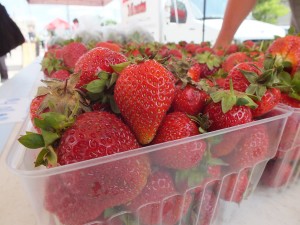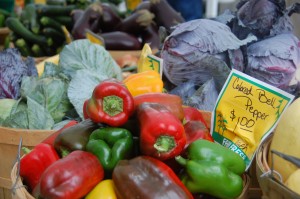Tips to extend the life of your produce
posted by Melissa on June 11, 2013 in TipsAccording to a report from the Natural Resources Defense Council, forty percent of food in the US is never eaten, equaling roughly 20 pounds of food each month. This amounts to $165 billion a year in waste.
A lot of food is wasted only because we don’t know how to store it correctly. Once you have narrowed down your shopping list, buy produce soon after its harvested – that’s when it’s freshest. Frequent your local farmers’ market, where fruits and veggies will have been picked only a day or so earlier. If your town doesn’t have a market, ask the produce manager at your local grocery store or food co-op what days the department receives deliveries, and plan your shopping trips accordingly.
At home, keeping produce fresh is all about management. All fruit produces ethylene gas, which helps it to ripen faster. If you leave it all in the fruit bowl or on a counter, it’s all going to ripen. For example, if your peaches start to ripen, put them in the fridge. If you notice any rotten or moldy produce, remove it immediately. One bad apple can spoil the whole bunch.
Keep produce whole as long as possible. Don’t remove the stems or wash it until you’re ready to eat it. If you do want to store sliced fruit or veggies, keep them in an air-tight container in the refrigerator, which limits moisture loss and exposure to bacteria.
 Keep cold-sensitive fruits (such as apricots, avocados, bananas, kiwis, mangos and melons) on the counter. For everything else, get familiar with your fridge, which has different temperature zones. Keep produce such as berries, citrus, corn, melon and peas in the front, where it’s warmer. Fruits such as apples, cherries and grapes can be stored anywhere because they are less susceptible to chill damage. Keep all refrigerated fruit away from leafy vegetables, which should live in the crisper drawer, along with artichokes, asparagus, beets, broccoli, cabbage, and carrots.
Keep cold-sensitive fruits (such as apricots, avocados, bananas, kiwis, mangos and melons) on the counter. For everything else, get familiar with your fridge, which has different temperature zones. Keep produce such as berries, citrus, corn, melon and peas in the front, where it’s warmer. Fruits such as apples, cherries and grapes can be stored anywhere because they are less susceptible to chill damage. Keep all refrigerated fruit away from leafy vegetables, which should live in the crisper drawer, along with artichokes, asparagus, beets, broccoli, cabbage, and carrots.
 Vegetables should also be specifically cared for as well. For root veggies, like carrots, beets, or radishes, trim the greens off before storing. These greens tend to pull the moisture from the root causing them to wilt prematurely. With leafy greens and herbs, wash and pat dry and then wrap in a damp paper towel and refrigerate in an open-ended bag. With eggplant and mushrooms, you should store inside a paper bag in the fridge. Most other vegetables can be kept in plastic bags or in the vegetable drawer including: broccoli, bell peppers, cucumbers, fennel, scallions, cauliflower, celery, brussel sprouts, summer squash and ginger.
Vegetables should also be specifically cared for as well. For root veggies, like carrots, beets, or radishes, trim the greens off before storing. These greens tend to pull the moisture from the root causing them to wilt prematurely. With leafy greens and herbs, wash and pat dry and then wrap in a damp paper towel and refrigerate in an open-ended bag. With eggplant and mushrooms, you should store inside a paper bag in the fridge. Most other vegetables can be kept in plastic bags or in the vegetable drawer including: broccoli, bell peppers, cucumbers, fennel, scallions, cauliflower, celery, brussel sprouts, summer squash and ginger.
And lastly, keep in mind that most fruit is going to have optimum flavor if eaten at room temperature. If you put a cantaloupe in the fridge, you want put it on the counter for 20 to 30 minutes to let it warm up before you cut into and eat it. Something to keep in mind before you serve a fruit salad at your next barbeque.




